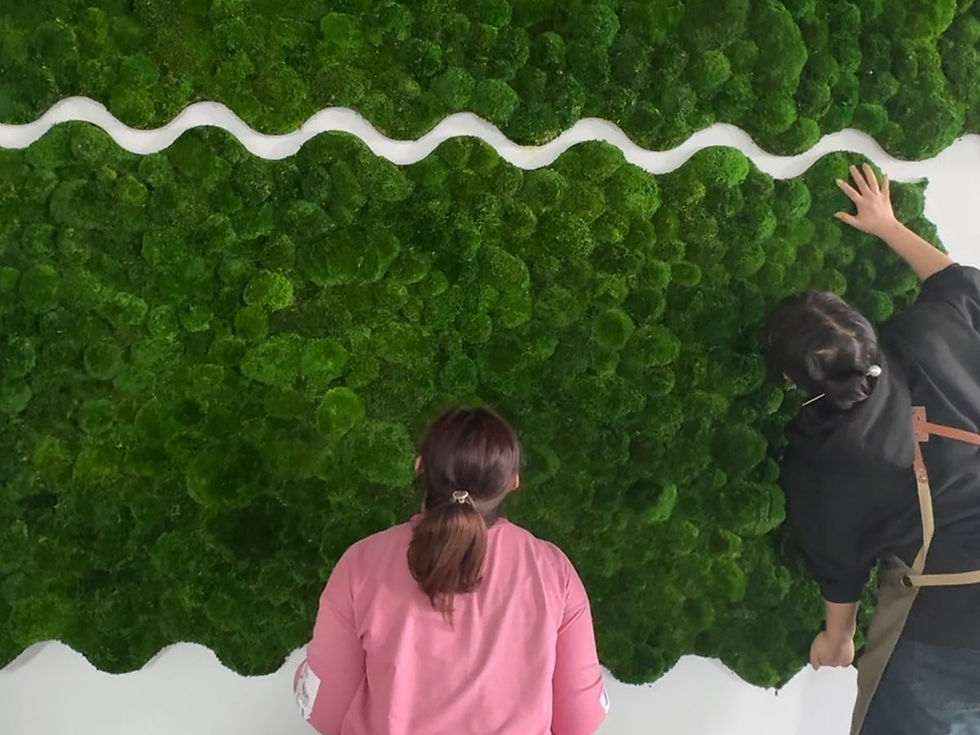
Preserved moss walls have become a familiar presence in interior design—but most remain decorative. But as designers look to apply moss to real commercial interiors, they often find that many systems aren’t built for it—falling short on the technical, functional, and regulatory demands of today's projects.
This article explores how a new generation of preserved moss systems is closing the gap between biophilic beauty and architectural performance.
Why Most Moss Walls Fall Short in Commercial Use
Moss walls are often chosen for their soft textures, calming presence, and natural appeal. But in real-world projects—offices, healthcare environments, retail spaces—most moss offerings fall short of spec.
They often:
-
Lack fire and acoustic testing
-
Offer no Declare, HPD, or VOC documentation
-
Are difficult to scale or adapt to complex spaces
As a result, moss is too often dismissed as an aesthetic gesture—visually compelling, but functionally limited.
What Makes a Moss System Commercial-Grade

To move beyond decoration, a preserved moss system must meet the expectations of modern architecture and design. That means:
-
Modular and scalable — adaptable to diverse spaces and interior typologies
-
Zero-maintenance — no irrigation, no artificial lighting, no plant swaps
-
Tested performance — certified fire resistance and acoustic absorption
-
Transparent documentation — full material disclosure and LEED support
-
Design integration — CAD/Revit-ready, with installation flexibility
These are no longer nice-to-haves—they're requirements for any biophilic system intended for lasting use in commercial interiors.
The Wildleaf Approach: A System Built for Architecture
Wildleaf was built to meet that commercial standard. We don’t just offer moss panels—we provide a full-scope preserved greenery system engineered for code compliance, design adaptability, and long-term architectural integration.
A performance-driven evolution in biophilic design
The Next Generation of Preserved Moss Systems for Commercial Interiors
May 15, 2025

Our moss systems are:
-
Full-scope and modular — adaptable to flat, curved, branded, or ceiling-mounted surfaces, with product modules including wall panels, planters, partitions, and lighting-ready elements
-
Zero-maintenance — preserved greenery requires no water, no light, and resists mold or pests
-
Fire-tested — ASTM E84 Class A
-
Acoustic-certified — ASTM C423 (NRC 1.01) supports acoustic wellness
-
Disclosed and certified — Declare documentation (Red List Free, uploaded), HPD v2.3 self-published and Passport-synced
-
Recognized — listed on mindful MATERIALS and ready to support specification
Every element is backed by real performance data and design-ready tools—because integration should never be an afterthought.
How Our Systems Support LEED v4.1
For architects and specifiers working on LEED-certified projects, Wildleaf moss systems are engineered to support a wide range of LEED v4.1 credits—up to 15 depending on project scope and application.
These contributions span categories such as:
-
Material Ingredient Reporting (via Declare and HPD)
-
Acoustic Performance (with NRC-rated assemblies)
-
Low-Emitting Materials (VOC-free, no wet-applied content)
-
Biophilic Design + Innovation (modular Red List Free systems with no maintenance burden)
WildLeaf provide complete documentation packages, formatted and aligned with submission workflows, to streamline LEED contribution tracking.
From Visual Feature to Integrated System
The next generation of moss systems offers more than surface aesthetics. It brings acoustic control, fire compliance, and documentation transparency into one plant-based, specification-ready platform.

For architects seeking a greenery systems feel without the logistical burden, Wildleaf offers a preserved moss solution ready for real-world design, compliance, and care-free longevity.
See Wildleaf in Person at AIA25

Join us at the AIA Conference on Architecture & Design 2025 in Boston. Stop by Booth #2435 to explore our moss systems firsthand—see the acoustic structure, feel the preserved texture, and get your hands on the documentation that makes it all spec-ready.
